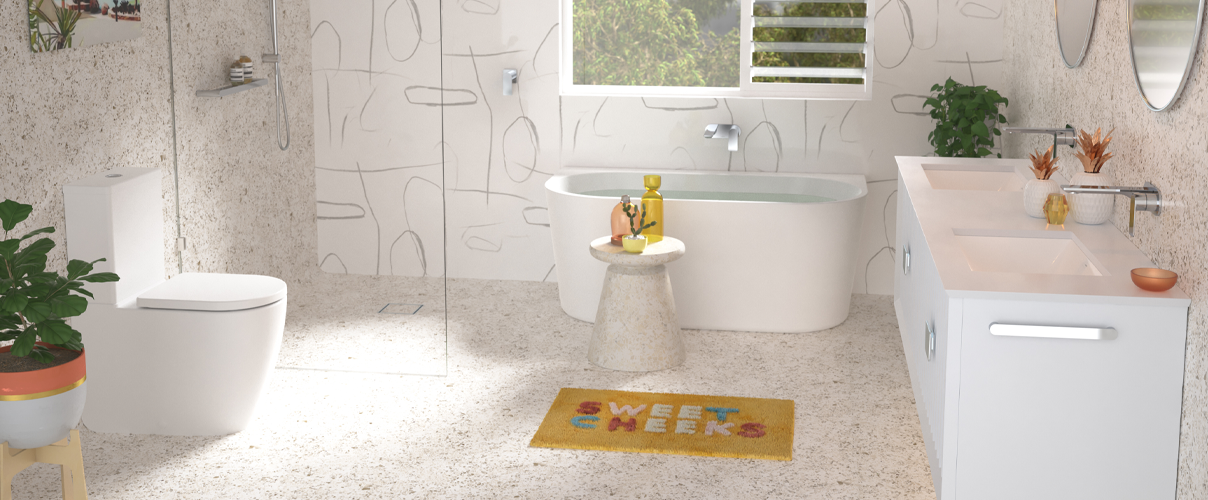Say Goodbye to Bathroom Mould: Prevention Tips for Your Renovation

If dreaming of the day you’ll finally be able to while away the hours in your newly renovated bathroom gets you all hot and sweaty, then there are some things you need to get right to truly enjoy your new-bathroom experience.
You see, bathrooms are a hotspot for mould – mostly because bathrooms get hot and sweaty when you use them – and this creates the perfect setting for mould to grow.
What Does Mould Look Like?
Mould can take a few different forms. It’s usually dark brown or black in colour and can be fuzzy or slimy to the touch. If you leave mould long enough or you get a large amount of it, it’s something you can smell too.
Where Can Mould Grow In A Bathroom?
Mould can grow wherever dampness exists. In a bathroom, it’s commonly seen in grouting and sealant, but it can also creep into cabinets, onto floors, and behind walls and ceilings.
Airborne mould spores are commonly found in both indoor and outdoor environments. When they land on damp spots, they may begin to grow and spread.
Getting ahead of the game and getting things right when you’re renovating could mean years of mould-free bliss in your new bathroom.
1. Get Your Drainage Right
When you have proper drainage in place in your bathroom renovation, water can flow away quickly, minimising the opportunity for it to linger and allow mould to grow. And by proper drainage, we mean well-designed slopes in the shower, and good-quality drainage products, just like these:
- Phoenix Tile Insert V Channel Drain : comes in a range of sizes and fits any floor tile to create a seamlessly integrated drain.
- Radiant Patterned Floor Grate : this square drain is modern by design and manufactured in 316 grade stainless steel.
- Art Australia Round Floor Waste : available in a white or chrome finish, this is a tried-and-tested traditional drainage solution.

2. Soak It Up, Baby!
After you channel Taylor Swift and ‘shake it off’, get out your moisture-soaking accessories (in other words, your mats and towels) and soak it up, Baby! They actively reduce surface moisture.
For example, putting a bathmat near the shower or bath catches drips when you step out, preventing water from soaking into the floor.
A hand towel beside a bathroom basin invites you to wipe your hands dry, saving drips from hitting the benchtop, taps, mirror, floor, and perhaps, if you have kids, even the ceiling, when you shake it off instead.
You can also wipe down tiles after bathing or showering and dry the shower tray and bathtub. The less moisture there is, the harder it is for mould to take hold.
Keeping your mats and towels clean and dry also helps keep the bathroom mould-free. So wash them a couple of times a week. And hang them on a hook, holder, rail, or rack when you’ve finished using them.
Browse our bathroom accessories range, which includes one of our all-time favourites for damp bathrooms – heated towel rails – to see what’s available. Choose from a beautiful range of products, available in chrome, black, nickel, brass, and rose gold finishes.
3. Plan To Ventilate
Whether you’re running the shower or taking a bath, heat and steam will fill your bathroom. To counteract this, add a fan or vent. Keep it running while you’re in there and for up to 30 minutes afterwards to ensure the space is completely dried out.
Depending on your bathroom’s position in your home, it might be possible to open a window while the bathroom is in use. This will allow the heat and steam to escape naturally. And if possible, leave your window ajar day in and day out.

4. Keep Things Smooth And Easy-care
Modern, smooth, easy-care materials for showers and baths also minimise the area in which mould can grow. As an added bonus, they are easier to clean. We have a great range of smooth shower bases, shower walls and bath/shower combos to choose from. And they don’t ask for compromise on style or quality. Check out our range.
5. Make Space For A Dehumidifier
By running a dehumidifier, you can lower the humidity in your bathroom, making it less welcoming to mould and mildew. Dehumidifiers are particularly useful in bathrooms with poor ventilation or in humid regions.
So make space for one in your bathroom renovation design, and it won’t feel like an inconvenient extra. This could include incorporating a wall niche near a power point, or adding a modern shelf like the Raymor Boston II , with its glass and chrome finish.
Can A Bathroom Renovation Really Help Solve A Mould Problem?
If you have a mould problem in your home now and are weighing up whether a bathroom renovation could help solve it, consider this. Unless you get to the core of the problem, you will continue to have a damp, mouldy bathroom. Once mould appears, it can be a challenge to remove it permanently unless you take proactive steps.
Depending on the extent of any existing mould problem, the steps you take could be large or small. If mould is growing behind your walls and floor, then it’s likely your bathroom will need a complete redo. But if it’s only a problem in your shower, then perhaps a partial renovation is all that you need.
Knowing what the first step should be is often the hardest thing to work out. But you don’t need to work that out on your own.
Visit any one of our 100+ showrooms around the country or even book an appointment with a Tradelink bathroom specialist.
Whether you have an existing mould problem or are just trying to prevent mould from becoming a problem in the future, they’ll have some great advice to share. Chances are, they’ve already helped someone just like you to solve the same problem.

